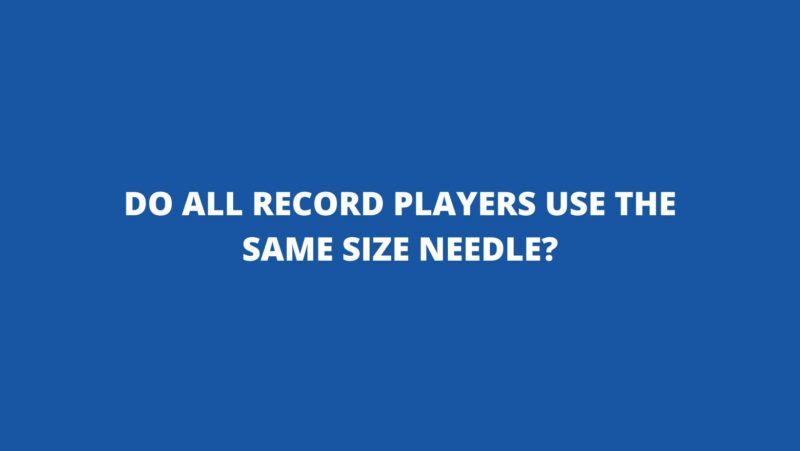The allure of vinyl records lies in their timeless appeal, offering a nostalgic and immersive auditory experience. Central to this experience is the stylus needle, a delicate yet pivotal component that traverses the grooves of records, translating physical vibrations into captivating melodies. As enthusiasts venture into the world of vinyl, a common question arises: do all record players use the same size needle? This question delves into the realm of stylus compatibility, addressing whether stylus needles are universally interchangeable among record players. In this comprehensive exploration, we will uncover the nuances of stylus sizing, discuss factors that influence compatibility, delve into the different cartridge types, and provide insights from experts to guide you in navigating the world of stylus compatibility.
Stylus Sizing: A Complex Landscape
Stylus needles come in various shapes, sizes, and configurations, each tailored to interact with different types of grooves and reproduce varying levels of sonic detail. The idea of a single-size-fits-all needle contradicts the intricate design of styluses and the diversity of vinyl records. Understanding stylus sizing is crucial to grasping the notion of compatibility:
- Stylus Shapes: Stylus needles can be conical, elliptical, microline, or other specialized shapes. Each shape has distinct tracking abilities and interactions with the record grooves, directly impacting sound quality and accuracy.
- Stylus Sizes: Stylus sizes are defined by dimensions such as width and height. These dimensions determine the contact area with the groove walls, affecting tracking ability and the level of detail captured.
Factors Influencing Compatibility
Compatibility between stylus needles and record players is influenced by several key factors:
- Cartridge Type: The cartridge, which houses the stylus, plays a significant role in determining stylus compatibility. Different cartridges require specific stylus shapes and sizes for optimal performance.
- Turntable Design: Turntable tonearms are designed to accommodate specific cartridge types and their associated stylus profiles. Matching the right stylus to the cartridge ensures proper tracking and playback.
- Tracking Force: Stylus compatibility extends to tracking force—the downward pressure exerted by the stylus on the grooves. An incompatible stylus can lead to excessive wear, damage, and compromised sound quality.
- Groove Type: Vinyl records are available in various formats, including microgroove LPs, 45 RPM singles, and 78 RPM records. Each format has distinct groove dimensions, requiring stylus needles tailored to those dimensions.
Understanding Different Cartridge Types
To comprehend stylus compatibility, it’s crucial to understand the different types of cartridges:
- Moving Magnet (MM) Cartridges: MM cartridges are common in many record players. They typically have replaceable stylus assemblies, allowing users to switch to compatible stylus profiles for varying sound quality and applications.
- Moving Coil (MC) Cartridges: MC cartridges are known for their intricate construction and superior sound quality. The stylus is an integral part of the cartridge and cannot be replaced separately. Users must choose an MC cartridge with the desired stylus profile.
- P-mount Cartridges: P-mount cartridges, also known as T4P cartridges, are designed for easy installation. They often have predefined stylus profiles and are widely used in entry-level turntables.
Expert Insights and Recommendations
Experts in the audio industry offer valuable insights to guide enthusiasts in navigating stylus compatibility:
- Research Cartridge Specifications: Understanding the specifications of your cartridge is essential. Consult the manufacturer’s recommendations for compatible stylus profiles.
- Explore Compatible Options: Many manufacturers offer multiple stylus options for their cartridges. Explore compatible options that cater to your desired sound quality and musical preferences.
- Consider Upgrade Kits: Some cartridges offer upgrade kits that allow users to replace the stylus assembly with a higher-quality version. These kits ensure compatibility and enhanced performance.
- Precision Alignment: Proper alignment of the stylus within the groove is critical for accurate tracking and optimal sound quality. Use alignment tools to ensure precision.
Conclusion
The idea of all record players using the same size needle is a myth that unravels upon delving into the intricacies of stylus design, cartridge types, and the diversity of vinyl records. Stylus compatibility is a multifaceted puzzle, wherein the right stylus must be matched with the appropriate cartridge and turntable design to achieve optimal performance.
As we navigate the realm of stylus compatibility, let us embrace the uniqueness of each record player and the artistry of vinyl playback. By understanding stylus sizing, researching cartridge specifications, and seeking expert advice, we can embark on a musical journey that honors the richness of analog sound, the intricacies of record grooves, and the sheer joy of exploring the diverse world of vinyl records.

